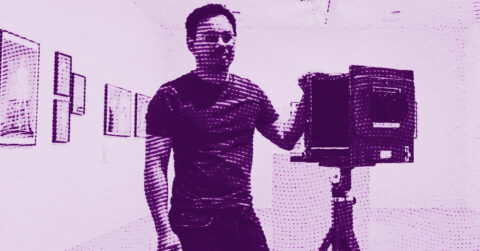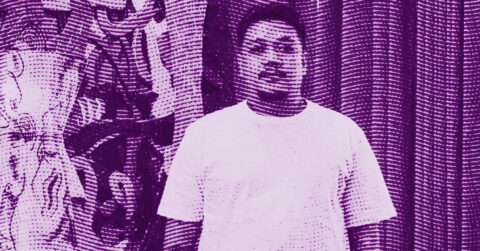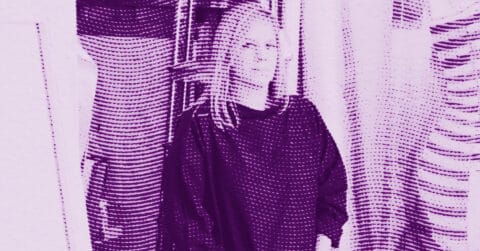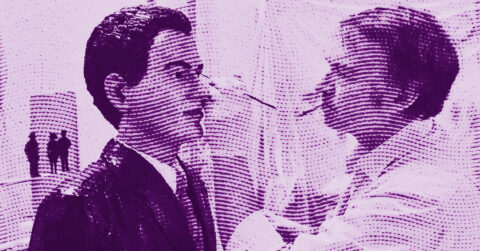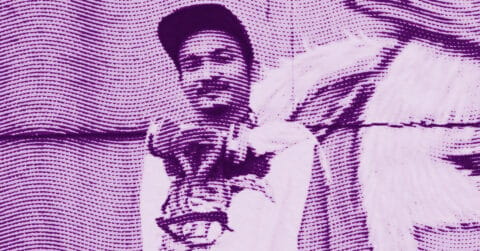Listen to me carefully, you bunch of snobs. Yes, you, with your convoluted theories on contemporary art. You who swear by incomprehensible video installations and performances where someone rolls around naked in paint while reciting Bob Dylan lyrics backwards. While you marvel at these conceptual nonsense, Tim Storrier does something far more radical: he paints. And not just anyhow.
I find myself unfortunately far from the vast Australian expanses, but Storrier’s work haunts me like a persistent blur. How has a man who draws ropes blazing in the desert managed to capture our era with such precision? How have his landscapes without human figures become the most faithful portraits of our condition?
Storrier was born in 1949 in Sydney and grew up in the rural regions of New South Wales. Imagine a child in the vastness of Australia, without television, absorbing Beethoven and Mozart, contemplating the works of Renoir and Degas that his mother hung on the walls of their home. A kid who, at just eight years old, was riding his old horse Taffy, a recalcitrant animal that regularly tried to unseat him. This childhood, far from the urban noise, forged in him a particular sensitivity to space and silence.
At just 19 years old, he won the Sulman Prize with “Suzy 350”, becoming the youngest laureate of this prestigious distinction. A precocity that would have been merely anecdotal if it had not announced an artistic journey of rare coherence. For Storrier has never yielded to the sirens of fashion. He has pursued his path, obstinately, to become one of the most singular painters of the contemporary Australian landscape.
What strikes in Storrier’s works is their irreproachable technical quality. In our era of the permanent draft, where the approximate gesture is often celebrated as a form of authenticity, his technical mastery sounds like an anachronism. Yet, this perfection is not gratuitous. It serves a profound purpose on our relationship with space, time, and absence.
Take his famous “burning ropes”, this series begun in 1981 when he set fire to a lacquered rope stretched between two points in the desert. This simple, almost minimalist image has become a powerful metaphor for our condition: we are all lines burning in the vastness, momentarily tracing our mark against a backdrop of nothingness. The finesse of the execution is not a mere display of virtuosity, but the means to make a metaphysical vision tangible.
The absence of humans in his landscapes is not an oversight, but a presence in hollow. As in “The Histrionic Wayfarer (after Bosch)” which earned him the Archibald Prize in 2012, where he represents himself faceless, a traveler overloaded with objects wandering in a desert landscape. “A burden is represented in The Histrionic Wayfarer, laden with the tools necessary to maintain the intrigue of a metaphysical exploration. Provisions, art material, books, papers, bedding, compass and maps, everything for the journey through the landscape of the artist’s mind,” he explains [1].
What makes Storrier strong is that he knows how to merge the particular and the universal. His landscapes are undeniably Australian, these endless horizons, these burnt ochres, these immense skies, but they speak of an existential condition that transcends borders. As Catherine Lumby writes so aptly in her monograph “Tim Storrier: The Art of the Outsider”, he is “one of the most popular and simultaneously one of the most elusive Australian artists” [2].
The solitude that permeates his work is not melancholic but ontological. It reminds us of our fundamental isolation in the face of the cosmic infinity. His starry skies are not pretty decorations but vertiginous abysses that refer us to our insignificance. Storrier is often accused of repeating himself, of endlessly recycling the same motifs. This criticism misses the essential: obsession in him is not a lack of imagination but a form of ascent. Like those Buddhist monks who endlessly trace the same mandala, he deepens certain themes until he extracts the essence. And then, what absurdity to reproach an artist for his coherence! Bach spent his life exploring the possibilities of counterpoint, Morandi painting minimal still lifes, and no one would think to accuse them of monotony. Storrier’s constancy is that of a researcher who digs ever deeper into the same vein.
His series “Impedimenta”, where he represents faceless figures bearing impossible burdens, resonates with particular depth in our era of frenetic accumulation. These anonymous beings, overloaded with heteroclite objects, painter’s palettes, canvases, papers, water reserves, are the perfect allegories of our cluttered existences. “These figures are autobiographical and, by implication, a kind of self-portrait”, he confides in a 2018 essay. “Ultimately, I suppose the dialogue in these works has to do with a lost fool walking endlessly towards a shimmering mirage.” [3]
What is remarkable about Storrier is his ability to maintain a constant tension between several registers. His work is both Australian and universal, technical and emotional, figurative and allegorical. This fundamental ambivalence allows him to escape easy classifications and ideological recuperations.
One can read his work in the light of Jean-Luc Nancy’s theories on the disavowed community. For the French philosopher, community is not based on a common essence or a shared project, but on the shared experience of our finitude and our separation. Storrier’s desert landscapes, traversed by lines of fire that consume slowly, perfectly illustrate this paradoxical community that is built on the recognition of our fundamental solitude.
In “La Vague (Garland)” (1998), a simple crown of flowers floats on a chained ocean. The image is of a striking beauty, but also of an absolute desolation. As John McDonald, critic at the Sydney Morning Herald, aptly notes, “It is as if the swimmer, or perhaps an entire boat, had already disappeared beneath the surface. The garland, a symbol of fragile beauty tossed by the waves, is also a funeral crown.” [4]
This memento mori dimension permeates all of Storrier’s work. His landscapes constantly remind us of our finitude, not in a morbid way, but as an invitation to humility and lucidity. In a world saturated with images and stimulations, where death is systematically concealed, this visual meditation on our mortal condition is not only salutary but subversive.
The disturbing character of his work paradoxically hides under the leached surface of his painting. For if Storrier perfectly masters academic technique, he places it at the service of a profoundly unsettling vision. His impeccably rendered landscapes are scenes of desolation, his magnificent skies overhang sterile lands, his harmonious compositions organize chaos.
This tension between formal perfection and existential anxiety echoes Julia Kristeva’s analyses on abjection in art. For the psychoanalyst, art allows us to confront what horrifies and fascinates us simultaneously. Storrier’s landscapes, with their calcined debris and abandoned objects, confront us with our own future decomposition, but do so with such beauty that the horror becomes bearable, even seductive.
Take his series “The Poetry of Detritus”, which explores the emotional charge of abandoned objects. In an essay of the same name, he tells how, as a child, he would rummage through the dumps in search of forgotten treasures: “When I was young, a nail could be a sword and a stone the canon of your homemade Springfield rifle, and you could wage the American Civil War in your room”. He concludes with this disillusioned reflection: “In the end, I suppose everything is lost, everything disappears forever. The only thing we leave behind is the miserable detritus of our supposedly exalted existence.” [5]
This melancholy is not merely personal, it is civilizational. Storrier perceives himself as a witness to a decline, a loss of cultural benchmarks. He deplores that art has become mere entertainment rather than a spiritual quest. His conservative stance, in a predominantly progressive artistic milieu, has often isolated him, creating what Lou Klepac calls “a moat around him”.
This outsider position paradoxically confers on him a rare freedom. Freed from the diktats of post-modernity, he has been able to develop a deeply personal work, anchored in a pictorial tradition that he fully claims. “I perhaps paint pre-modernist paintings. Perhaps, I hope”, he affirmed in 2018.
Storrier’s brutal frankness can sometimes be disconcerting. He does not mince words when it comes to criticizing the contemporary artistic establishment, which he accuses of yielding to intellectual fashions to the detriment of aesthetic research. This combative stance masks a deep sensitivity that can be found in his most successful works.
For behind the provocative Storrier hides an artist of rare sensitivity. His series of faceless self-portraits, in particular, reveals a complex reflection on identity and self-representation. As Ashley Crawford explains, “Storrier uses absence as presence. He defines the contour by the void, suggesting that identity is not a fixed given but a constellation of attributes and experiences.” [6]
This dialectic between presence and absence runs through all his work. His desert landscapes are inhabited by an absence that weighs heavier than any presence. His abandoned objects evoke their disappeared owners more powerfully than their direct representation would. This visual apophasis, defining something by saying what it is not, gives his work a rare metaphysical depth in contemporary art.
If one wanted to situate Storrier in an artistic genealogy, one would have to place him somewhere between Friedrich, for his sublime landscapes that confront us with our own insignificance, and de Chirico, for his deserted spaces charged with an unsettling strangeness. But this filiation does not do justice to the singularity of his vision. For Storrier is above all a painter of the Anthropocene before the letter, an artist who visually documents our impact on the world and our own disappearance to come. His landscapes marked by human absence, traversed by lines of fire or strewn with debris, prefigure a post-human world where only the traces of our passage would remain.
This prophetic dimension of his work is rarely commented on, overshadowed by technical discussions on his virtuosity or ideological debates on his conservatism. Yet, few artists have been able to capture with such acuity our ambiguous relationship with the environment, our morbid fascination with destruction, our will to impose our mark on landscapes that will outlive us.
Storrier’s greatness lies precisely in his ability to transform the local into the universal, the personal into the archetypal. His Australian landscapes become metaphysical theaters where the drama of our mortal condition is played out. His everyday objects, chairs, beds, clothes, become symbols charged with an unsettling familiarity. In 2017, he won the Doug Moran National Portrait Prize with “The Lunar Savant”, a portrait of his colleague artist McLean Edwards. This return to explicit figuration, after years of exploring absence, shows that Storrier remains an artist in motion, capable of reinventing himself while remaining faithful to his fundamental preoccupations.
In an artistic world that often values novelty at the expense of depth, Storrier’s constancy may seem anachronistic. Yet, it is precisely this fidelity to himself that makes his strength. He has built, canvas after canvas, a work of remarkable coherence, a corpus that unfolds like a long meditation on our place in the universe.
Tim Storrier is not an artist who seeks to please or to confirm our certainties. He confronts us with our essential solitude, with the terrible beauty of our ephemeral condition, with the indifferent immensity that surrounds us. If his work disturbs us, it is because it touches truths that we usually prefer to ignore.
In the deafening noise of contemporary art, his singular voice resonates like a call to silence and contemplation. A reminder that painting, far from being an obsolete practice, remains one of the most powerful means of exploring our relationship with the world and with ourselves. So the next time you pass by one of his gilded canvases, do not stop at the technical virtuosity or the apparent beauty. Dive into these empty spaces, let yourself be consumed by these lines of fire, lose yourself in these immense skies. For Storrier’s work is not made to be admired from afar, but to be inhabited, as one inhabits a poem or a dream.
- Tim Storrier, accompanying text for “The Histrionic Wayfarer (after Bosch)”, Art Gallery of New South Wales, 2012.
- Lumby, Catharine, “Tim Storrier: The Art of the Outsider”, Craftsman House, Sydney, 2000.
- Storrier, Tim, “Impedimenta”, 2018, essay published on his official website.
- McDonald, John, “Tim Storrier”, Sydney Morning Herald, November 26, 2011.




